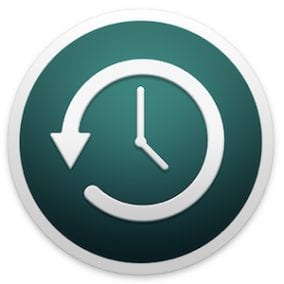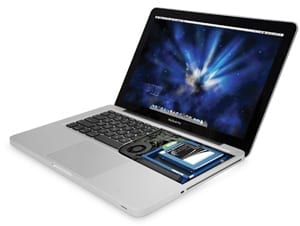![]() We’ve talked about backing up your data quite extensively here on the OWC Blog. We’ve talked about different backup strategies. We’ve discussed mirrored RAID devices like the NewerTech Guardian MAXimus and how they can fit into your backup scheme. We’ve touched on how you need to keep an eye on your backup software to make sure it’s doing what it’s supposed to.
We’ve talked about backing up your data quite extensively here on the OWC Blog. We’ve talked about different backup strategies. We’ve discussed mirrored RAID devices like the NewerTech Guardian MAXimus and how they can fit into your backup scheme. We’ve touched on how you need to keep an eye on your backup software to make sure it’s doing what it’s supposed to.
It’s in the vein of that last one that we bring you this little tidbit from Lloyd Chambers of MacPerformanceGuide. It seems that Lloyd has found a bug in Time Machine that may cause your Mac to ignore drives under some circumstances. We highly recommend checking out the full article out for the complete analysis of the issue.
The lesson to be learned from all this is that when it comes to backups, the more the merrier. While some backup is better than nothing, it’s always safest to have multiple backup methods in place at once. While I do use Time Machine here on my work machine, it is mainly for retrieval of accidentally-deleted files (I use this a lot more often than I care to admit) and to supplement my daily cloning of my drives using Carbon Copy Cloner. This current method has worked for me for several years now, and has saved me from at least one major drive crash, so I’d say it’s functional. I’d also rotate those clones out at least weekly, but that’s not a practical solution at this time.
So what are you using for backup?








Hi everyone. I started back a couple of months ago researching to upgrade my iMac late 2009 27″ i5 to upgrade it with an SSD 3G drive 240GB and by the same means, change the internal drive that was 5 years old. So my supplier’s on-line Tech team were such an amazing source of information and help during this process, but not the only source! I used different blogs and also a youtube video that saved my life which helps user create a bootable USB key I recommend you look at especially if you don’t have hard OS copies with you, just lookup jbtech how to create a bootable os x usb on Youtube. Also, make sure your backup has the same OS version of the the USB key, I suggest making sure your using latest version then do a full backup before proceeding with switch.
My research brought me to invest in a Guardian Maximus RAID firewire enclosure a couple of months ago, again very happy I spent the money on a 2X4TB Raid 1 Back up system.
So I proceeded with the hardware change over the week-end and to my surprise when came time to use Time machine fully restore my hard drive, it always failed after 13.1%! I could never get past that number! I spent hours searching only to find out hundreds of comments on different blogs. I was starting to loose faith when Disk migration was failing because it could not recognize the HDD, only the SSD drive. I told myself, thank god my old internal drive is still functional and that I had a external enclosure available. So I logged on to the on line tech team from my supplier and proceeded the following way: Used time-machine to restore all softwares to the SSD drive, and manually copying the balance of the data over in the old drive to drive method. I just can’t believe how lucky I was and how unreliable time-machine was in this situation. I can’t believe it failed the restore procedure and I basically was in trouble if my old drive had crashed…..
Hello,
I have installed the Datadoubler and I am satistied of the solution. However, using the 2nd drive “datadoubler” to backup the first is not what I want. So, I wanted to use timemachine to backup both drive to an external one. The timemachine see the data of both drives and calculates the total amount of both drives and starts to backup. But at one point the second drive unmounts. I looked at the forum, and hardly enough I do not see a thread concerning this problem.
Is this a limitation, is there a solution to properly backup the data?
First drive is a SSD Mercury 1TB
Second drive is 2TB SATA
Thank you
A couple of things you will want to check is the size of your Time Machine drive and check what Operating System (OS) you are currently running.
In previous Operating Systems (10.5 -10.7) you were only able to have one drive with your Time Machine. With the introduction of 10.8 Mountain Lion you were able to use multiple drives. You will want to make sure you are at least running 10.8.
The external Time Machine Drive you have will need to have the same amount or more space than your two drives combined. If you exceed the amount of space in your Time Machine drive, the internal drive(s) will drop off and the transfer will not complete.
If you have confirmed that you are running 10.8 or later and have more than enough space on your Time Machine drive I would recommend contacting our Technical Support Team!“
Hi, I have been looking at setting up my mac as a Fusion Drive setup, with the OWC Mercury and Data Doubler in my MBP. While waiting for it to come, there are some questions that bugs me, leaving me unable to decide if I should do a Fusion Drive or Separate my bulk data. Here are my Questions.
1) If I were to set up a Fusion Drive, will Time Machine will backup every file in the OS (SSD and HD) as one volume, hence to restore it to a single drive would be no problem?
2) If i were to Use an SSD as my boot disk, manually linking my user data to my Hard Disk, would Time Machine back up the data in my HDD as though my System is on one drive?
(http://eshop.macsales.com/installvideos/owc_techknowlogy/keeping_system_files/)
Thanks in advance!
Cheers,
Mitchell
You can configure Time Machine to backup both drives in either setup.
So means that if I used the way they I left in the link, Time Machine would back it up as a whole drive as a single volume even if my files are manually split in my 2nd disk?
I am being given a new Imac 27″ for Christmas and am interested in getting a reliable backup system for a home office situation.
Can you please advise the best solution.
Pat
Ps I am not technically minded!
The video linked to in this post will give you the best overview of the different types of backup available.
As to what would work best for your particular needs, we would love to assist. Please call us at 1(800)275-4576, chat with us online, or send us an email and we’d be happy to help find the right backup solution for your particular needs.
Several layers:
1. My writing files (small, frequently modified) are in a Dropbox folder, so they’re backed up in real time, offsite.
2. My internal drive and external media drive are backed up via Time Machine hourly to another external.
3. I clone these two drives once a month with Carbon Copy Cloner, and keep the clones at an offsite location. The clones are encrypted using core encryption built into OS X.
Between Dropbox and Time Machine, I’m covered for accidental deletions, modifications or corruption of everything. And the offsite clones are my “worst scenario” fall-backs. Starting from those (and with Dropbox bridging the gap), I could recover everything really important in the event of a catastrophe or theft at my apartment.
Backup outside your location is crucial for important filles. I use time machine on my local network and Backblaze for cloud backup
I use rsync to backup files to an encrypted sparse image on an external drive. I have a number of these drives, all with sparse images of the same title encrypted with the same password (which is saved in my Finder so I don’t have to remember it). Once a month I shuffle the drives between home and work, ensuring that no two drives are in the same place at the same. Rsync has no problem with the differing drives, correctly backing up whatever has changed since the last time that drive was mounted.
Each sparse image is much larger than the drive it resides on, allowing me to easily copy the image to a larger drive if need be without having to resize the image (or copy the data to a new image).
I quite like the idea of encrypted backup. If someone steals a drive (onsite or off) my only loss is a cheap external drive.
For versioning backup I rely on Dropbox backing up my working directory. The way Dropbox can act as a poor-man’s versioning system has saved my bacon a couple of times.
We run a Mac Mini Server running a RAID 1 with the two internal drives for hardware redundancy. I’ve had to replace each of the factory drives so far due to failure. The RAID saved our bacon in those instances.
We then run nightly incremental backups using Carbon Copy Cloner to an external drive in a Newer Technology Voyager drive dock, alternating drives every week or two. This gives us a way to go back and grab deleted files, and store backup data off site.
I initially found running Time Machine on the server to be unreliable. And if I don’t trust it, I’m not going to use it for company critical data. However we do back up our Mac Pro workstations over Time Machine to a spare internal drive. This is more for “oops, did I delete that?” or if the Mac Pro drive fails, we can get a station back up quickly.
It’s a simple, inexpensive solution that covers us in just about any event.
I have also used Time Machine for some time. I have not noticed any issues at all except as what MaX noted. I have also had to infrequently unmount disks and then remount them. This kind of behavior has not happenend in my case.
My storage is initially backed up in the form of RAID 5. I have a 4x2TB setup in my Mercury QX2. I have another 4x2TB RAID 5 setup that I use as my Time Machine backup. It may seem like overkill, but there’s a lot of irreplaceable data as well as painfully time-consuming-to-replace digital media, and this setup gives me peace of mind for my onsite backup needs.
Which version of Time Machine and OS X has such bug?
I have been using Time Machine for years and it has worked always fine except when the free disk space is low (the solution was to make a fresh backup from scratch).
According to the original Mac Performance Guide article, “This occurred with OS X Lion and still occurs as of August 2012 with OS X Mountain Lion.”